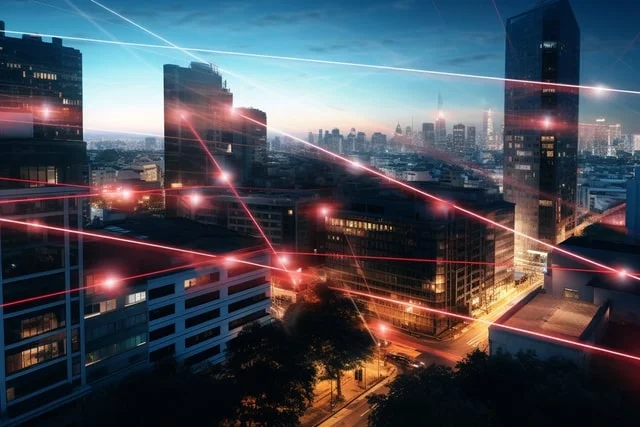As urbanization continues rapidly around the globe, connected buildings provide an opportunity to reduce the significant environmental impact of the built environment. By integrating Internet of Things (IoT) devices and intelligent software systems, connected buildings create smart, efficient, responsive, and data-driven infrastructure.
What is the concept of smart connected buildings?
In the simplest terms, a smart connected building uses advanced automation to control and monitor its environment. But there’s more to it than that. These buildings use a combination of IoT devices, sensors, and software to collect, analyze, and utilize data. This data includes everything from energy usage to foot traffic to create a more efficient, comfortable, and sustainable space.
Examples of intelligent buildings
Let’s look at some real-world examples to better illustrate the concept.
‘The Edge’ in Amsterdam, for instance, is often hailed as the world’s greenest and smartest office building. It uses a smartphone app for navigation, lighting, and temperature control that it also gathers data from. On top of the smartphone app, it also has 6,000 smart lights on an IP-based LED system and 30,000 sensors to gather data on building use. These technologies are the main reason ‘The Edge’ consumes 70% less electricity than normal office buildings of this size.
On the flip side of reacting to occupant behavior, Berlin’s ‘The Cube’ learns from its occupants using a centralized AI system called the ‘Brain.’ This AI system uses data from thousands of sensors and beacons to dynamically adapt building systems to its occupants’ needs. The dedicated app helps occupants work more efficiently by streamlining workspace reservations, navigation, and parking.
IoT in smart buildings
So, where does IoT come into play? IoT devices create the backbone of these smart buildings. They’re the devices that collect data, control building systems, and allow for real-time adjustments. In The Edge, for instance, the connected lighting system is an IoT device. It collects light usage and occupancy data while enabling user control over lighting levels.
In a smart building, IoT devices control everything from the office coffee machine to the entire heating, ventilation, and air conditioning (HVAC) system. These devices constantly communicate with each other and the building management system to create an interconnected web that drives building intelligence.
When does a building become connected?
A building doesn’t become smart overnight. It’s a transition that involves the integration of various technologies, systems, and components to form an interconnected network. This network then collects, analyzes, and leverages data to automate and optimize the building’s functions.
Definition, explanation and components
Connected buildings refer to any building with an intelligent, automated system that controls and manages the building’s operations. The system requires a few key components to interact, share data, and make real-time adjustments. Here are the basic components every connected building needs:
- IoT devices: Physical devices, like sensors and smart lights, that collect and transmit data.
- Sensors: Devices that detect changes in the environment, such as occupancy or temperature, and send this information to the system.
- Building management system (BMS): Often considered the operation’s brain, it receives data from the IoT devices and sensors, processes it, and makes decisions about controlling the building’s systems.
- Network infrastructure: Comprising routers, switches, and other equipment, network infrastructure enables communication between the components.
What are the benefits of connected buildings?
Automating building functions with real-time data insights through a connected building comes with a wide range of benefits including:
- Energy efficiency: By intelligently managing energy use, these buildings greatly improve efficiency, leading to lower operating costs.
- User experience: Occupants enjoy a more comfortable and customizable space, with personalized lighting, temperature control, and more.
- Streamlined maintenance: Smart buildings can simplify the process of upkeep and repairs, making it easier for property managers and owners.
- Enhanced safety: With better control and monitoring of systems, smart buildings can significantly improve safety by effectively restricting areas and monitoring occupant movements.
- Data-driving decisions: The wealth of data collected from smart buildings can inform better decision-making about space usage, facility management, and more.
Connected buildings contribute to more sustainable and efficient building management and can also help building owners follow the ESG green buildings framework. The data collected by connected buildings collect valuable insights into energy usage, waste production, and occupant behavior. These insights can be used to implement strategies that align with ESG standards, driving environmental sustainability while enhancing social governance and yielding economic benefits.
Environmental benefits and creating smart cities
Beyond the building itself, connected buildings have broader implications for sustainability and urban development. They’re a key component of smart cities, where data and automation are used to improve quality of life and reduce environmental impact. However, this transition requires building owners to adapt to smart cities by turning traditional buildings into connected ones.
On a larger scale, if more buildings become smart, we can reduce the 37% global carbon emissions that the Commercial Real Estate (CRE) industry contributes. This could be a major step towards meeting global sustainability goals and creating greener, smarter cities.
What does automation have to do with it?
Automation is the cornerstone of a connected building – the engine that powers its intelligence. The key element transforms an ordinary structure into an efficient, responsive system.
The automated systems in a connected building are integral to its functionality. They fully manage critical operations such as heating, lighting, and security with immediate feedback from real-time data. Like a well-rehearsed orchestra, these systems must sync to ensure optimal performance and efficiency.
ProptechOS free trial: Get connected today
Dive into the future of property management with ProptechOS. This comprehensive platform combines your real-time data from every source and then distributes that data to all of your Proptech solutions.
But how does this help you transform your real estate into connected buildings? It comes down to how it works.
ProptechOS enables you to create ‘Digital Twins‘ of your properties by integrating all your data streams. These virtual replicas facilitate a detailed understanding of your buildings, from energy usage patterns to occupancy trends.
On top of Digital Twins, ProptechOS’s distribution capabilities mean that your digitized data can be easily accessed by all your Proptech solutions. This ease of access promotes interoperability between different systems, enhancing efficiency and effectiveness. The results? A seamlessly connected building ecosystem where every component communicates and collaborates to optimize building performance.
Try out ProptechOS for free today and see how creating a connected ecosystem for your building data can drive efficiency.

Dr. Erik Wallin
Chief Ecosystem Officer, and founder of ProptechOS and RealEstateCore is recognized as a leader in Building Operating Systems (BOS) and making the buildings of the world smarter. He holds an MSc and a Ph.D. in Media and Computer Science from KTH Royal Institute of Technology.
Read his full bio and information here.

